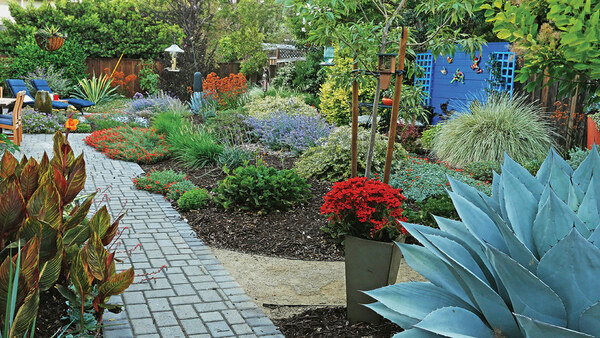
Author Donald Pell’s career in horticulture started when he was 19 and eventually evolved into a landscape design practice that is located on a 14-acre farm in Chester County, Pennsylvania. This is where you’ll find an extensive series of naturalistic gardens that Donald and his team of designers use as a laboratory. Within the beds and borders, these professionals are constantly experimenting with plants, trying out different design ideas, and studying the way a plan expands over time. Donald says, “Much of my growth and expertise has come from the sheer excitement of learning from failures and from the many years of watching our landscape design evolve.” Establishing a garden based on an initial design is a great place to start, but as plants, the setting, conditions, our knowledge, and our tastes change, so should our designs. Uncontrollable changes in a garden are inevitable and wonderful opportunities. During Donald’s three decades of experience, he’s developed pain-saving design strategies and helpful pivots to get the greatest visual impact from a landscape over a long stretch of time. These include:
- Composing with plants of equally competitive natures
- Working with the site challenges, not against them
- Embracing changes, reassessing needs, and being willing to pivot
The following photos appeared in Donald’s article, Designing for Impact Over the Long Haul, and perfectly illustrate gardens (designed by Donald) that have stood the test of time. See the plant IDs below for areas of this beautiful garden so that you can recreate these gorgeous designs.
- Autumn moor grass (Sesleria autumnalis, Zones 5–8)
- ‘Purple Smoke’ baptisia (Baptisia ‘Purple Smoke’, Zones 4–9)
- Cutleaf staghorn sumac (Rhus typhina ‘Laciniata’, Zones 3–8)
- ‘East Friesland’ salvia (Salvia nemorosa ‘Ostfriesland’, Zones 4–8)
- Philadelphia fleabane (Erigeron philadelphicus, Zones 2–7)
- ‘Wesuwe’ meadow salvia (Salvia nemorosa ‘Wesuwe’, Zones 3–8)
- ‘Totally Tangerine’ geum (Geum ‘Totally Tangerine’, Zones 4–7)
- ‘Magnus’ purple coneflower (Echinacea purpurea ‘Magnus’, Zones 3–8)
- ‘Purple Smoke’ baptisia (Baptisia ‘Purple Smoke’, Zones 4–9)
- Philadelphia fleabane (Erigeron philadelphicus, Zones 2–7)
- ‘East Friesland’ salvia (Salvia nemorosa ‘Ostfriesland’, Zones 4–8)
- ‘Windspiel’ purple moor grass (Molina caerulea subsp. arundinacea ‘Windspiel’, Zones 4–9)
- ‘Totally Tangerine’ geum (Geum ‘Totally Tangerine’, Zones 4–7)
- ‘Wesuwe’ meadow salvia (Salvia nemorosa ‘Wesuwe’, Zones 3–8)
- ‘Honorine Jobert’ anemone (Anemone × hybrida ‘Honorine Jobert’, Zones 4–8)
- ‘Karmina’ hardy geranium (Geranium × cantabrigiense ‘Karmina’, Zones 5–8)
- Frost grass (Spodiopogon sibiricus, Zones 5–9)
- ‘Firetail’ mountain fleece (Persicaria amplexicaulis ‘Firetail’, Zones 4–7)
- Gooseneck loosestrife (Lysimachia clethroides, Zones 3–8)
- Bear’s breeches (Acanthus mollis, Zones 7–10)
- ‘Greenlee Hybrid’ moor grass (Sesleria ‘Greenlee Hybrid’, Zones 5–9)
- ‘Filigran’ Russian sage (Perovskia ‘Filigran’, Zones 5–9)





















Comments
Log in or create an account to post a comment.
Sign up Log in